Glasses industry and pad printing process
With the gradual establishment of a market economy in our country, various industries have begun to enter a stage of stable development. As an industry closely related to people’s daily life, the glasses industry is naturally no exception.
There are thousands of enterprises engaged in the production of glasses in our country, with tens of billions of dollars in consumption each year. Although this is not too big a cake, but as a daily consumer goods, its market is still very huge. The content of this article does not involve the development of the glasses industry, but rather the printing done by businesses to compete for consumer recognition of products. It should be said that the continuous enhancement of brand awareness has made producers pay attention to etching marks on the surface of products to become fashionable, and allowing consumers to identify their favorite brands and styles through eye-catching text or graphic information has been valued by more and more companies.
Glasses are composed of lenses and mirrors. The edge area of the lens close to the blind spot of the eye usually needs to be printed, and the center of the nose pad of the frame and the sides of the temples are all parts that can be printed. In order to wear it lightly, the frame is usually forged and processed from steel with light weight and good toughness. The frame is very narrow, usually between 1mm and 2mm. In such a small space, product numbers are usually printed to distinguish a wide range of glasses styles. Most of the lenses are made of glass with extremely high transparency, and some of the lenses of the glasses are made of resin sheets, and the logos of the printing manufacturers are used as decorative means on the lenses.
The reason why pad printing is used for lens printing is that pad printing can be printed on a smooth and curved surface, and laser marking will cause damage to the lens surface. In addition to pad printing, the frame printing can also be done by laser marking. Both pad printing and laser marking can achieve decoration on a very small area, but they have obvious differences: laser marking actually has an etching effect and can be stored forever: pad printing pictures and texts are easy to peel off, but you can choose whatever you want Color to increase the eye-catching effect. From the perspective of cost, the price of laser marking machines is between 100,000 yuan and 200,000 yuan, which is a large investment, while the price of pad printers is only about 15,000 yuan, which is much smaller.
Using etching method to obtain graphics and text is also a common practice to replace laser marking. The glasses industry usually uses ferric chloride solution to make etching graphics and text. However, a potential threat of etching technology is the destruction of the environment. Today, when society is paying more and more attention to the health of operators, its use is greatly restricted.
Pad printing element control
The most significant feature of pad printing is indirect printing. The biggest advantage of indirect printing is to maintain the independence of the position of the printing plate and the substrate. The change in the shape of the pad printing rubber head that transfers the ink on the printing plate to the surface of the substrate makes the shift The adaptability of printing technology to the shape of the substrate is greatly enhanced.
Now we will give a brief introduction to the process issues involved in the printing of pad printing technology on glasses, so that everyone can understand the general situation of the application of pad printing technology in the glasses industry.
1, ink selection
Ink selection occupies a very important position in pad printing technology, which is related to the wide range of printing materials involved in pad printing technology. Since the frame is made of metal, the ink is required to have good adhesion on the metal surface. Now, two-component inks are commonly used, and they are dried by drying. The printing of lenses requires glass ink, which is usually a two-component ink and is dried by drying. The cured ink layer of the two-component ink has the characteristics of high hardness and good adhesion, but the operation is slightly more troublesome.
The usage method of two-component ink is briefly described as follows:
(1) First add the hardener to the ink according to the ink instructions, stir it evenly, and pour it into the oil pan for printing. Since the two-component ink will cure slowly, the dosage should be controlled.
(2) After printing, it should be placed in a drying box for drying treatment to speed up the drying speed. Two-component inks generally have a drying time of up to 10 hours at room temperature, which will affect production efficiency. Drying is ideal. Usually the drying temperature is between 150°C and 180°C, and the time is 5 minutes to 10 minutes. minute.
- Pad printing plastic head The choice of the pad printing head in the pad printing process is very important. First of all, the shape of the pad printing rubber head must be able to print to the specified position, and secondly, ensure that the deformation is small. Since the printing area of the frame is very small, the pad printing rubber head should be slightly pointed. Through the test, the A7 rubber head with a cross-sectional area of 38mm is more suitable. The printing effect of the A3 plastic head is also very good, but because the cross section is slightly smaller, the printing distortion is slightly larger. The hardness of the pad printing rubber head is another indicator that should be considered when choosing. The softer rubber head has wider adaptability, but the printing image and text are deformed. Especially for printed products as small as glasses frames, the graphic text is very small, and the large deformation of the graphic can easily cause the adhesion between the graphic lines and the blur, so it is better to choose a harder plastic head. Our test The result is that the plastic head with a Shore hardness of 32 degrees can achieve the best printing quality. The rubber head selected for the printing of the nose pad should consider the location limitation, and the rubber head with a smaller cross-sectional area should be selected. Our test result is that the rubber head with the cross-sectional area below 15mm is more suitable, and the hardness should also be above 32 degrees.
- Printing plate
The printing plate of the pad printing machine is a steel plate, and the method of making the steel plate is the corrosion method. The printing pictures of the frame and the lens are very small, so the size of the steel plate does not need to be too large. According to the standards of various industries for pad printing, steel plates of 75mm×100mm and 100mm×100mm can be used, and the length of the longest side of the printed pictures of the glasses frame is only 20mm, so the pictures and texts can use 75mm×100mm steel plates.
The steel plate is made by traditional corrosion method. Due to the small font size and shorter exposure time, a steel plate with uniform depth can be obtained.
For steel plate production, depth control is a major indicator. Too deep depth is easy to cause paste, ink transfer is affected, and the strokes of the font are easy to be uneven in thickness, the spacing between the strokes becomes smaller, and the definition decreases. The disadvantage of too shallow depth is also obvious, this is that the color saturation of the font is not high, and the color is difficult to achieve eye-catching effects. The result of our experiment is that the depth is ideally controlled at 19μm.
4. Pad printing machine
The printing area of the glasses frame is small, it is only the trademark of the printing company, so it does not involve complicated graphics, nor does it involve color registration. The selection of the machine should be a small single-color pad printer.Such as DX-MINI-90 one color desktop pad printing machine from Shenzhen Dstar Machine Co.,ltd.It’s small size and economic for printing glasses.
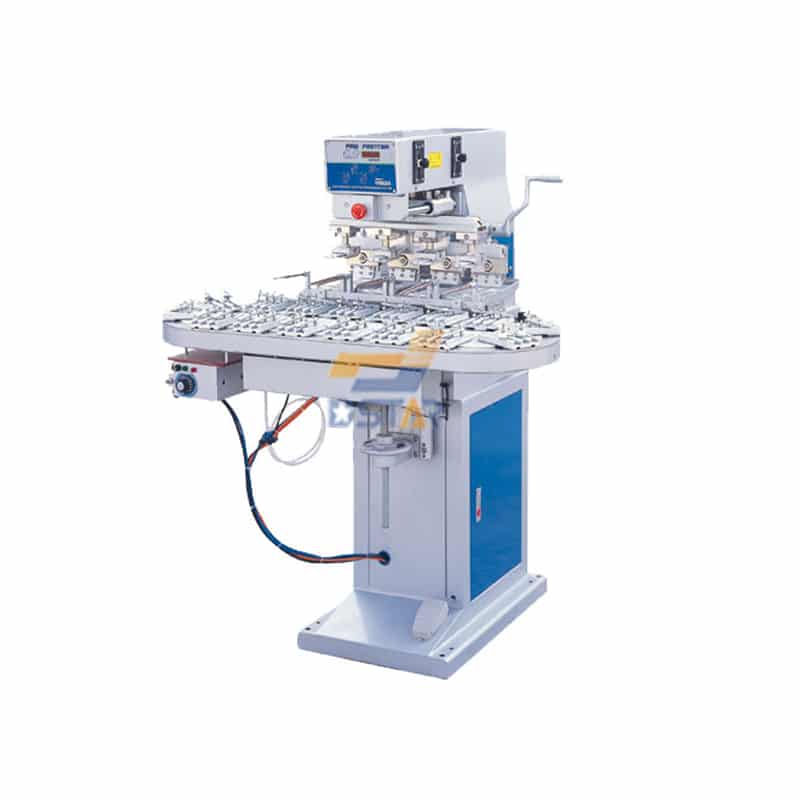
4 color pad printer DX-S4C 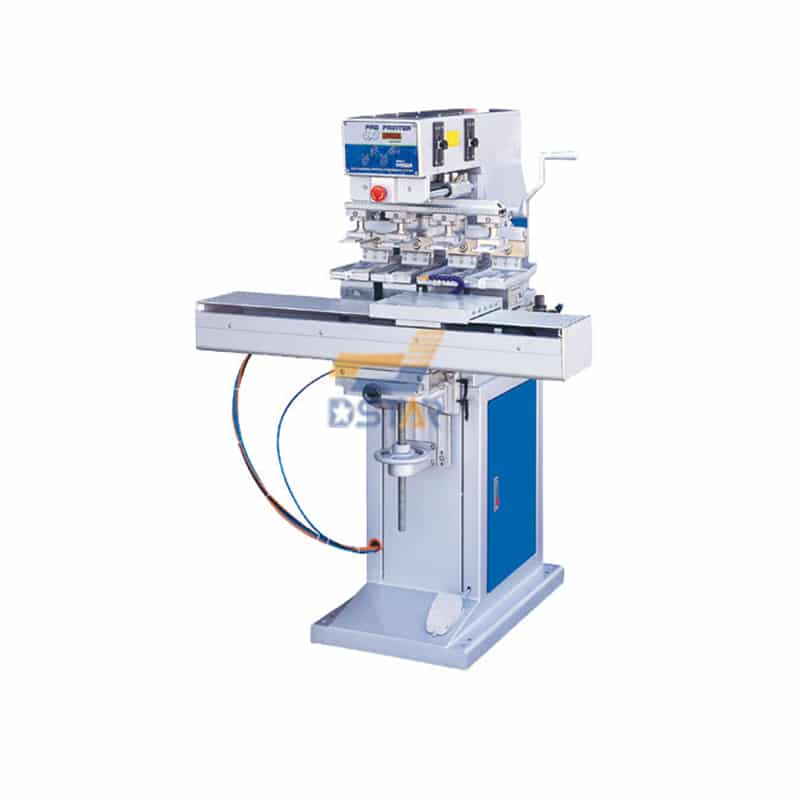
4 color pad printer DX-M4S 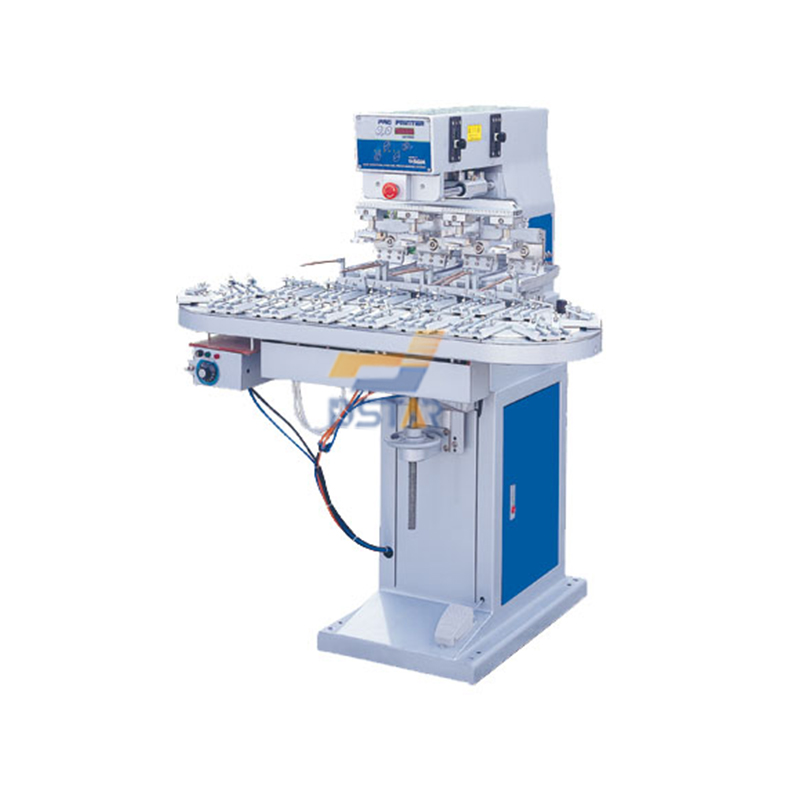
4 color pad printer DX-P4C 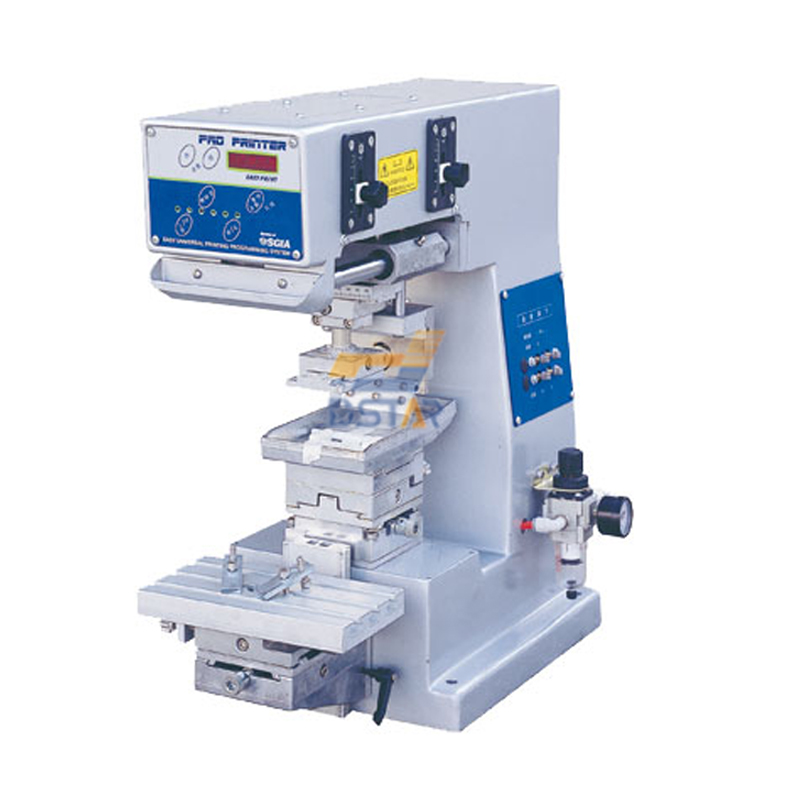
1 color pad printer DX-MINI 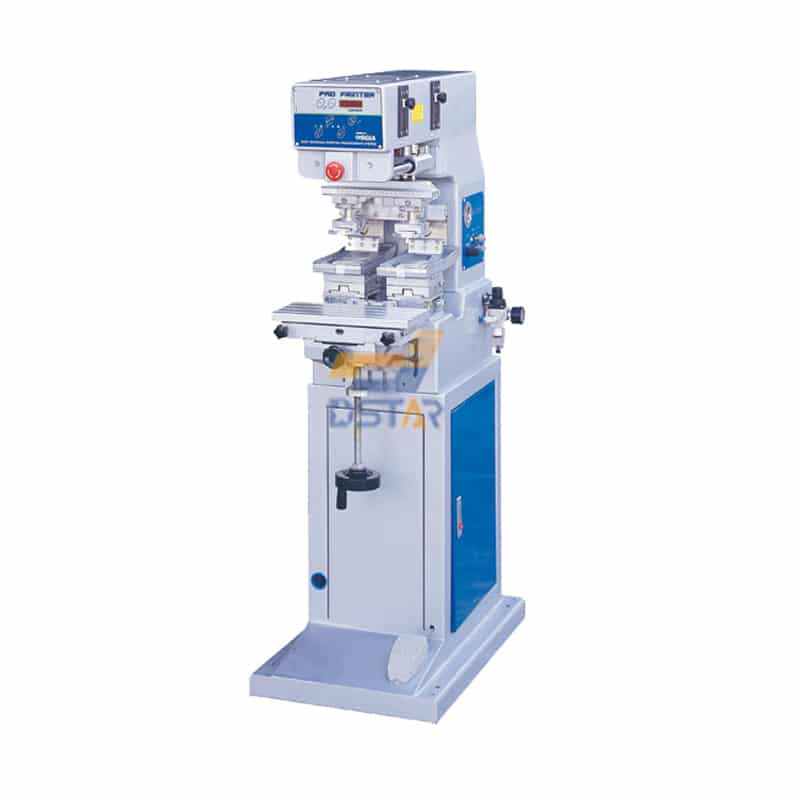
1 color pad printer DX-MINIB2H 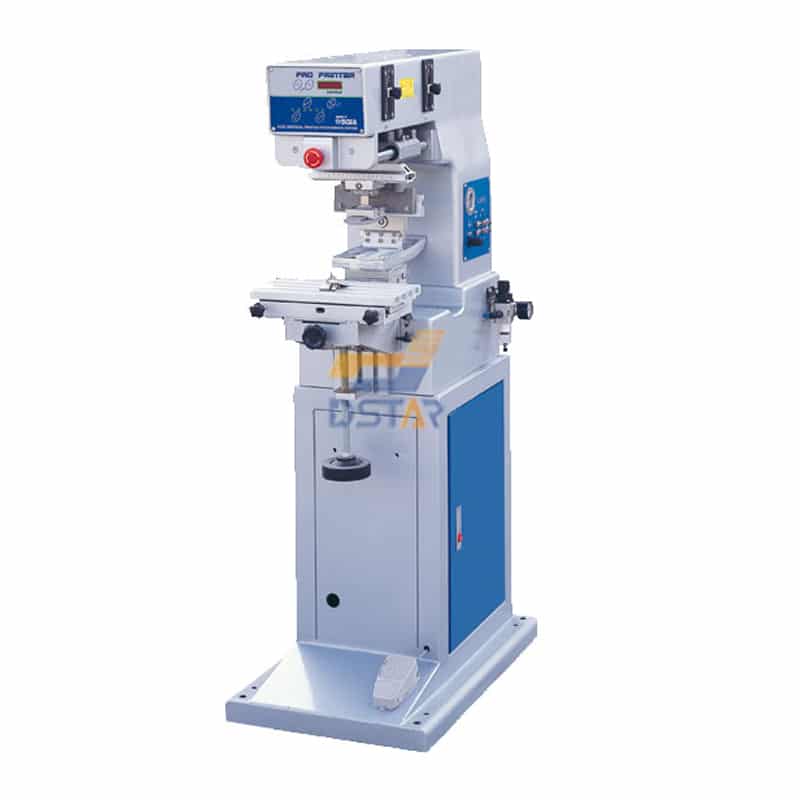
1 color pad printer DX-P1
5. Fixture
In the specialty printing industry, making fixtures is a basic job. Generally speaking, the main purpose of making a jig is to ensure that the printing area of the substrate.and the plastic head have a relatively fixed position to ensure the uniformity of product printing. At the same time, it is easy to achieve accurate overprinting when multi-color overprinting is involved.so the position of the fixture in the pad printing process is indispensable. The inner edge of the spectacle frame is the area for printing pictures and texts.and this position must be clamped by a clamp to ensure that it is parallel to the pad printing head. During the printing process, the spectacle frame should not be loosened, and a good tightening effect is required. The fixture cast with crystal glue should be the first choice.
The crystal glue casting method is made by the principle that the unsaturated polyester resin is cured under the action of the hardener, and it is very easy to solidify and shape according to the shape of the product. No matter how complicated the structure of the spectacle frame is, the fixture made by this method can fix the spectacle frame well and meet the printing requirements. The production method is: first mix and stir the resin A component and the B component evenly and pour it into the pre-prepared paper type until the resin appears in a gel state, then take out the spectacle frame.
Although the pad printing of the frame and lens is a very simple process.it can be seen that the characteristics of the pad printing process:
Pad printing is very suitable for products with a small printing area and irregular printing positions; it is the special parts that need to be printed on glasses products that enable the pad printing process to be used wonderfully.
From the point of view of the printing process, in order to achieve exquisite printing results.choosing high-quality pad printing inks and relatively high-hardness pad printing rubber heads are two factors that must be paid attention to.
The quality of the pad printing is inseparable from the quality of the fixture.
concluding remarks
The application of pad printing technology in the glasses industry illustrates at least two problems.First, if any company wants to gain more market share in the ever-changing market, in addition to continuously improving the level of technology in the manufacturing process, the characteristics of its products. The use of various decorative methods is becoming an issue of increasing concern for business managers. For the vast majority of consumers, eye-catching product information and instructions are more likely to stimulate their desire to buy.
Another problem is: human beings start from manufacturing the first product.although they gradually understand the division of labor, the division of labor will never be separated from the internal connections between industries.especially the connection with printing. When people are at a loss as to what to do in the fierce market competition, they might as well invest their eyes in another industry, and perhaps find new inspirations. Pad printing is a kind of industry that is easy for people to inspire. As long as you use your brain a little, a creative solution will be produced quickly. With these exquisite solutions, no one will be afraid of any competitors.
The market economy is cruel and fair. Companies that are creative and good at eating crabs tend to take the lead. We respect the first company that applies the pad printing process to the glasses industry. They are already at the forefront. We will also respect those companies that will expand the pad printing process to new areas in the future. Similarly, they will also be in the industry.
 DSTAR machine
DSTAR machine

WeChat
Scan the QR Code with wechat